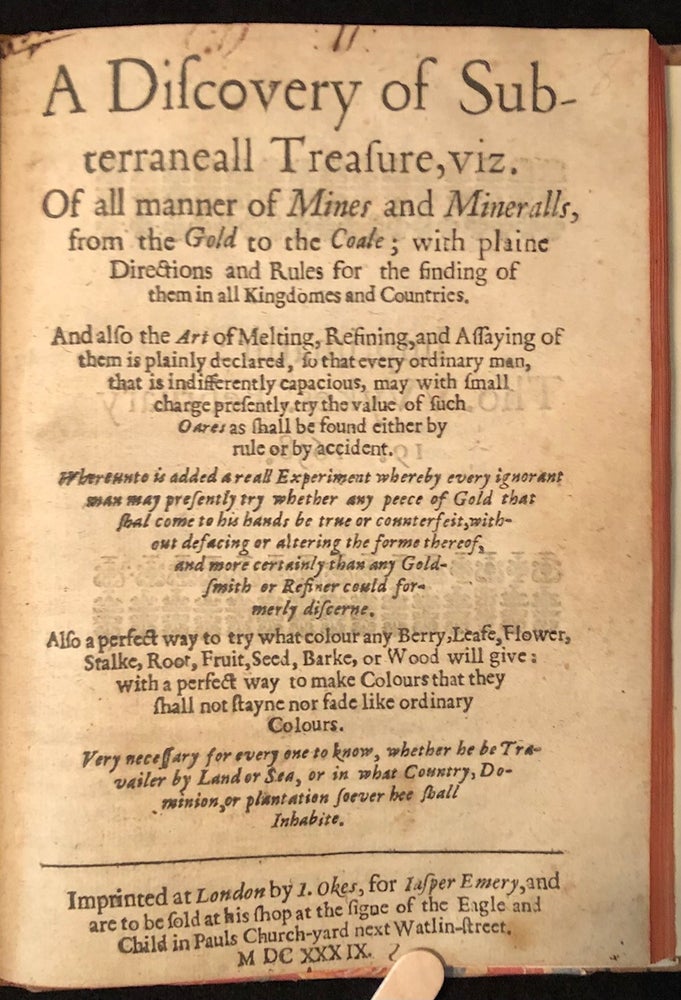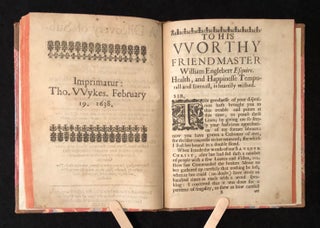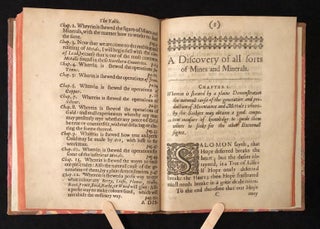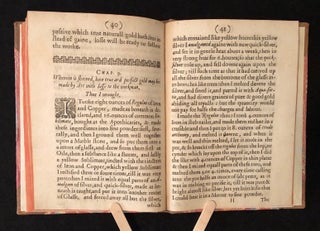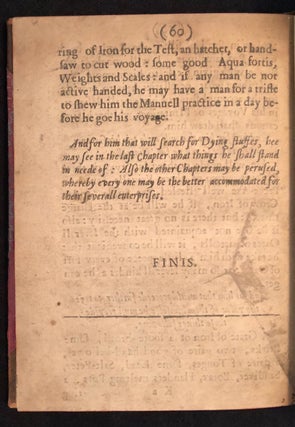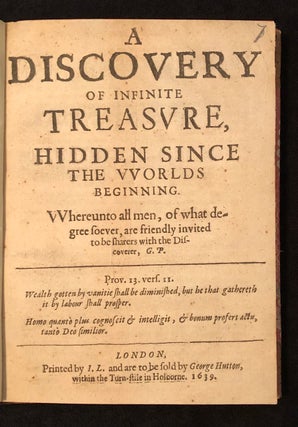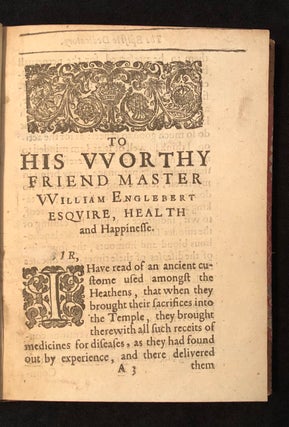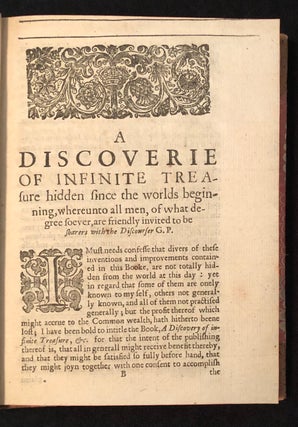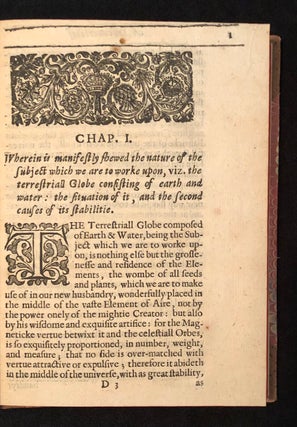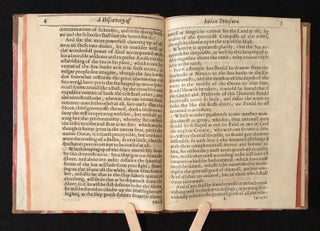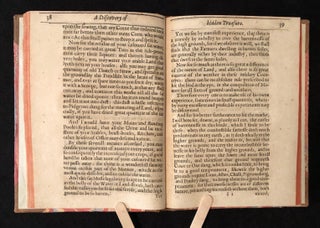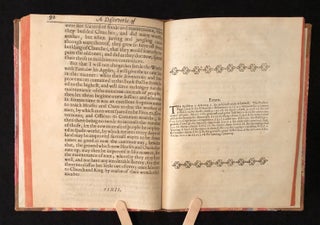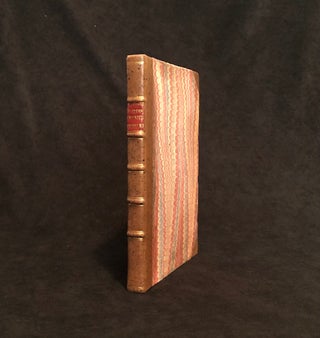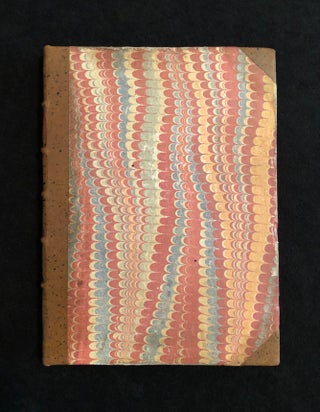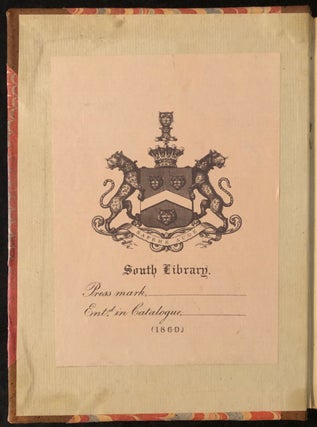A Discovery of Subterraneall Treasure (bound with) A Discovery of Infinite Treasure
A fine pairing of first editions of the English scientist and husbandman Gabriel Plattes's first two books: A Discovery of Infinite Treasure, a pioneering work on idealized solutions to agriculture problems, and A Discovery of Subterraneall Treasure, one of the first major works on mining, metallurgy, and geology in English. It has been asserted that the two books were complementary, though there is in fact little evidence of this. They were the products of different printers, approbated ten months apart, sold retail at opposite ends of London, and entirely distinct in both purpose and subject matter. That said, we note that Plattes himself states, in the epistle dedicatory to Subterraneall Treasure, that one should also read (and buy) Infinite Treasure (which he mentions was published in 1638), as it is a path to success in husbandry in precisely the same way the latter book is a path to success in mineral prospecting. But Infinite Treasure was actually an almost utopian approach to the economic and practical problems of agriculture and tenancy, intended to be read by members of Parliament at the end of Elizabeth's reign. The book was likely a perseveration of Plattes's Description of the Famous Kingdome of Macaria, a 15-page dialogue after More's Utopia, which the author willed to Samuel Hartlib, who published it under his own name in 1644. In the 12 chapters of Infinite Treasure, Plattes outlines his plan, beginning with a general (and prescient) discussion of global climates, and narrows the focus to specific economic issues of providing tools for and feeding workers, recent advances in husbandry, the diseases of corn and sheep, and the beneficial nature of collective labor. (We notice with interest that Plattes recommends that for every tree a farmer cuts down, three more should be planted, a custom at work in Spain.) He concludes with a list of objections to his ideas, supposedly supplied by farmers with whom he was acquainted (but which were actually probably composed by Plattes himself), and artfully rebuts each. Subterraneall Treasure, on the other hand, has no specific political-economic agenda, and is instead a kind of book of secrets whose subject matter is mining, metallurgy, crust geology, and alchemy, with a long, slightly off-topic concluding section on mordants and dyestuffs. Plattes mentions in the text that he has discovered a method for turning lead to gold, but is keeping the process secret because it is more costly than the resulting gold. Where Plattes's two books intersect is in their attention paid to the Americas. In Infinite Treasure, the author observes:
For if a streight line should be drawne from the Sea banks at Mexico to the Sea banks in the easterne coasts, and the measure of the depth of the water in the middle of the Ocean to that line, should likewise be taken, it would be found that if the Guider and Preserver of this Universe should be remisse never so little, and suffer the water to sinke flat like the fresh rivers, we should all be drowned in an instant.
And in Subterraneall Treasure, Plattes recounts this story, illustrating the ease with which even ordinary men could strike riches in the New World:
For I could wish that many men had the like fortune that one had, who in the climbing up of the great Mountaine called Potersee, in the Kingdome of Perue in the West Indies [Mt. Potosí, in modern-day Bolivia] took hold of a young Tree to stay himself withall; and thereby plucked it up by the roots, whereunto there did adheare good Silver Oare; which when being tried and found rich, hath ever since been wrought upon: and innumerable treasure and riches have therehence been digged, to the valew of many hundred Millions of pounds Sterling.
Later in Subterraneall Treasure, Plattes remarks upon the success of the new plantations in New England, Virginia, and Bermuda, and states, essentially, that if it's so easy to get rich as a planter in the American colonies, then it must not be far removed to find veins of precious metals there with the naked eye, which enterprise woulds surely realize a greater return in a single year than all the tobacco ever produced. According to Lowndes, Plattes died of starvation on the streets of London about 1644. Though the two books are in a later binding, they seem to have been together ab initio.
Full titles:
A | DISCOVERY | OF INFINITE | TREASVRE, | HIDDEN SINCE | THE VVORLDS | BEGINNING. || VVhereunto all men, of what de- | gree ſoever, are friendly invited to be ſharers with the Diſ- | coverer, G. P. | [Rule] | Prov. 13. verſ. ii. | Wealth gotten by vanitie ſhall be diminiſhed, but he that gathereth | it by labour ſhall proſper. || Homo quantò plus cognoſcit & intelligit, & bonum profert actu, | tantò Deo ſimilor. | [Rule] | LONDON, | Printed by I. L. [Legat] and are to be ſold by George Hutton, | within the Turn-ſtile in Holborne. 1639.
(Bound with)
A Diſcovery of Sub- | terraneall Treaſure, viz. | Of all manner of Mines and Mineralls, | from the Gold to the Coale; with plaine | Directions and Rules for the finding of | them in all Kingdomes and Countries. || And alſo the Art of Melting, Refining, and Aſſaying of | them is plainly declared, ſo that every ordinary man, | that is indifferently capacious, may with ſmall | charge preſently try the value of ſuch | Oares as ſhall be found either by | rule or by accident. || Whereunto is added a reall Experiment whereby every ignorant | man may preſently try whether any peece of Gold that | ſhal come to his hands be true or counterfeit, with- | out defacing or altering the forme thereof, | and more certainly than any Gold- | ſmith or Refiner could for- | merly diſcerne. || Alſo a perfect way to try what colour any Berry, Leafe, Flower, | Stalke, Root, Fruit, Seed, Barke, or Wood will give: | with a perfect way to make Colours that they | ſhall not ſtayne nor fade like ordinary | Colours. || Very neceſſary for every one to know, whether he be Tra- | vailer by Land or Sea, or in what Country, Dominion, or plantation ſoever hee ſhall | Inhabite. || [Rule] || Imprinted at London by I. Okes, for Iaſper Emery, and | are to be ſold at his ſhop at the ſigne of the Eagle and | Child in Pauls Church-yard next Watlin-ſtreet. | M DC XXX IX.
London: J. Legat and J. Okes, 1639.
Two books in quarto, 183 x 140 x 16 mm (binding), 180 x 138 x 13 mm (text block). I: A4 a4 B-P4 Q2; [33], 92, [1] pp. A2 title a cancellans; stub of cancellandum visible. Wanting A1, a blank, but errata leaf (Q2) present. II: [A]2 B-I4 K2; x, 60 pp. Wanting [A]1, a blank. Modern quarter sprinkled calf over marbled boards, titled in gilt on morocco lettering piece in second compartment. Interior: Margins a bit precious, the binder's plough having touched a few headline rules in the first book, and the signature and catchword on G2r in the second. Last two leaves toned and dusty. Good, crisp copies of both books.
The Macclesfield copy, with their South Library bookplate (1860) to upper pastedown.
Ad I: STC 19998 (stating approbation to J. Legat awarded 10 December 1638); ESTC S114836; Ferguson II 207-8; Ferguson (Glasgow) II 567; Goldsmiths'-Kress 00696.2. Ad II: STC 20000; ESTC S100866; Sabin 63360; Lowndes III 1880; Alden-Landis 639/94.
Item #222
Price: $7,200.00

